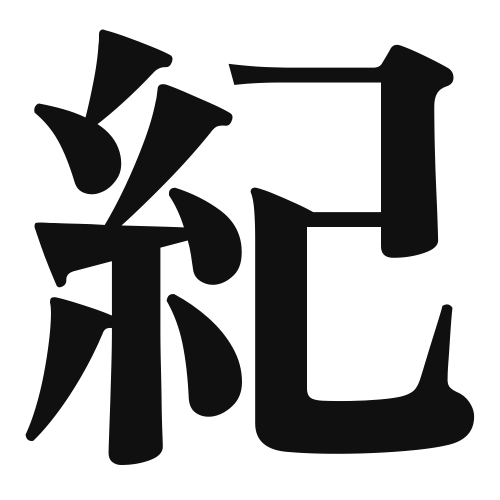1. Overview of Meaning
The kanji “紀” (ki) generally means “chronicle,” “record,” or “history.” It is often used to refer to the documentation of events or the passage of time.
2. Formation and Radical
Formation of the Kanji: The kanji “紀” is a compound character (会意文字) that combines elements to convey its meaning. It consists of the radical “糸” (ito), which means “thread,” and the character “己” (ki), which can represent oneself or the self. This combination suggests the idea of weaving together threads of history or events.
Radical: The radical of “紀” is “糸” (ito), indicating its connection to textiles and the concept of weaving, which metaphorically relates to the recording of events in a chronological manner.
3. Examples of Usage
Common Words and Phrases: Some frequently used words that include “紀” are:
- 紀元 (kigen) – “era” or “epoch”
- 紀行 (kikou) – “travelogue” or “journey record”
- 年代記 (nendaiki) – “chronicle” or “annals”
Example Sentences in Daily Conversation:
- この本は日本の歴史を紀元から記録しています。
(This book records Japanese history from the era.) - 彼は旅行の紀行文を書いています。
(He is writing a travelogue of his journey.)
4. Synonyms and Antonyms
Similar Kanji: A kanji with a similar meaning is “歴” (reki), which also relates to history but emphasizes the passage of time and events rather than the act of recording.
Opposite Kanji: An antonym could be “忘” (wasure), meaning “to forget,” as it represents the opposite of recording or remembering events.
5. Cultural and Historical Background
Connection to Japanese Culture: The kanji “紀” is often associated with historical texts and chronicles in Japan, such as the “Nihon Shoki” (Chronicles of Japan), which is one of the oldest historical records in Japanese literature.
Proverbs and Idioms: One common saying is “歴史は繰り返す” (rekishi wa kurikaesu), meaning “history repeats itself,” which reflects the importance of understanding history to learn from past events.
